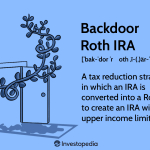2023 tax season reduction strategies if you earn over 6 figures $100,000
These days the price of almost everything is higher, from food to housing, to the cost of goods and services and even people that make 6 figures a year or more are feeling the squeeze of inflation, taxes, and cost of living adjustments on their money. In places such as the Bay Area or NYC, or even Socal, a 6 figure salary does not go as far as it used to. Bloomberg recently reported that during the pandemic, with the flexibility of remote and hybrid work, high-earners have been moving to lower-tax states such as Florida from those expensive cities I just mentioned. Generally, tax advisors say people should be focused on lowering their taxable income. If you’re in a high tax bracket, you’ll be happy to know that there are a variety of tax reduction strategies for high-income earners.
Review options during big life-changing events
In the Bloomberg article Jordan Gilberti, a financial planner at Facet said, “people with high incomes should constantly review their options amid life changes, like having kids, buying a home or getting a big raise.” Obviously, tax planning is a year-round strategy it’s not done in April when it comes time to file. Here are some tax-saving tips that could apply to high-earning individuals in the United States.
Make sure you max out retirement savings accounts
Not all high-earning individuals take full advantage of retirement plans, and the consequences of not doing so mean missing out on tax-deferred growth and matching contributions from employers, In 2023, employees can contribute up to $22,500 to a 401(k) and $6,500 to an IRA. The limits for workers over 50 are even higher: $30,000 for a 401(k) and $7,500 for an IRA. Households with combined finances should consider maxing out contributions to both retirement plans.
Tax tip: if you changed jobs last year, make sure that your contributions under both plans don’t exceed the annual limit.
Contribute to Health savings accounts and College 529 plans
Sometimes people forget about contributing to savings accounts for health expenses and college costs. Consider a health savings account (HSA): If you have a high-deductible health plan, you may be able to contribute to an HSA, which can be used to pay for medical expenses tax-free. Contributions to an HSA are tax-deductible, reducing your taxable income.
Similar to retirement accounts, making payments to a health savings account (HSA) or 529 plan for a child’s higher education can bring tax breaks. HSAs allow you to set aside money for healthcare costs, like doctor’s appointments and medications. The HSA contribution limit this year is $3,850 for individuals and $7,750 for family coverage.
Due to the low contribution limits of a HSA, some people think they are not that appealing but these types of accounts have a tripled-pronged tax benefit:
- money goes into the account before taxes
- it compounds and grows tax-deferred
- and can come out tax-free when used for qualified medical expenses
According to the IRS, money put into 529 plans is tax deductible in some states, and can be used to pay expenses such as tuition, books, computers and room and board. Contributions can range up to $85,000 per beneficiary in a single year.
Don’t forget to review and take all deductions and credits
Higher tax bracket income earners may qualify for a variety of tax credits and deductions, such as some for making charitable donations. If you regularly give to donations and happen to have a year with higher revenue, you can decide to donate a much larger amount in that single year instead of spacing it out. Bunching contributions can be a useful an effective strategy for maximizing the tax benefit you’ll receive.
Don’t forget about the home office deduction, While employees aren’t eligible for the deduction, business owners and freelancers who regularly use part of their home as their primary place of business often underestimate what they can claim. Often times people wrongly assume that this deduction is solely for expenses occurring in a home office, like the cost of a new desk, This deduction works by taking a proportionate amount of costs related to the entire home, like mortgage interest, insurance and repairs.
Don’t ignore tax deduction phaseouts
A financial planner named Jeff Mcdermott told Bloomberg that “when income tops $100,000, taxpayers should keep track of when they become ineligible for deductions or tax breaks because they make too much money,” For example, eligibility this year for Roth IRA contributions end over a modified adjusted gross income, or “MAGI,” range of $138,000 to $153,000 for single filers.
If someone accidentally ends up making an ineligible contribution, fixing it can be an administrative annoyance, and not fixing it in a timely manner can lead to IRS tax penalties for as long as the ineligible contribution remains in the account.
Another example, generally when someone earns more than $100,000, they are not eligible to take deductions on student loan interest, since that’s a tax break that phases out for those exceeding a MAGI of $85,000.
Make sure you keep records
Keeping accurate records to prove the legitimacy of filing for and claiming deductions and tax breaks is the cornerstone of protecting yourself in case of a potential audit or penalties.
Be careful when reporting “backdoor IRA” contributions
A “backdoor IRA” is a strategy used by high-earners whose income is higher than the limit to contribute directly to a Roth IRA. Instead, they convert a traditional IRA to a Roth IRA, which means paying tax on the conversion but then afterward getting to take qualified withdrawals tax-free. But the rules are complicated, so take it slow.
Mr. Gilberti, a financial planner at Facet told Bloomberg, there are some common issues that happen when people utilize backdoor IRAs. He said, “in many cases, filers either don’t report the IRA contribution and the conversion all together, or they report the conversion from the IRA to the Roth IRA as taxable, which means they pay double the taxes on their money.”
Have a clear understanding of how bonuses are taxed
In the financial services industry and others, often times a significant portion of professionals’ income can come in the form of a bonus. And often times a yearly bonus makes up a substantial portion of many high-income earners’ compensation. But there are two different ways bonuses can be taxed, so it’s important to know which method your company uses.
Some companies tax bonuses separately from regular salaried pay as supplemental wages, which are subject to federal income tax withholding at a flat rate of 22% (as of 2023) regardless of the employee’s regular tax bracket. However, state and local taxes may also apply, depending on the jurisdiction. But issues can arise for high-income earners because they may be in a higher tax bracket and need to know how their bonuses are taxed and adjust their withholdings accordingly. If they don’t they could be in for tax surprise when they go to file their returns.
Employers are required to withhold this flat rate on bonuses unless they choose to use the optional flat rate of 37% for supplemental wages over $1 million in a calendar year.
People should also be aware that bonuses may be subject to additional taxes, such as Social Security and Medicare taxes. These taxes are typically withheld at the standard rates, and the total amount of taxes withheld will be reflected on the employee’s W-2 form at the end of the tax year.











